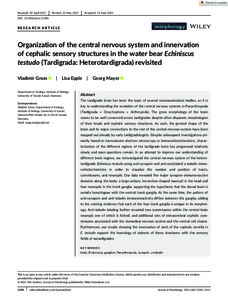| dc.date.accessioned | 2021-08-23T13:14:22Z | |
| dc.date.available | 2021-08-23T13:14:22Z | |
| dc.date.issued | 2021-06-15 | |
| dc.identifier | doi:10.17170/kobra-202108104524 | |
| dc.identifier.uri | http://hdl.handle.net/123456789/13153 | |
| dc.description.sponsorship | Gefördert im Rahmen des Projekts DEAL | ger |
| dc.language.iso | eng | eng |
| dc.rights | Namensnennung 4.0 International | * |
| dc.rights.uri | http://creativecommons.org/licenses/by/4.0/ | * |
| dc.subject | brain | eng |
| dc.subject | Ecdysozoa | eng |
| dc.subject | ganglion | eng |
| dc.subject | Panarthropoda | eng |
| dc.subject | synapsin | eng |
| dc.subject | α‐tubulin | eng |
| dc.subject.ddc | 570 | |
| dc.title | Organization of the central nervous system and innervation of cephalic sensory structures in the water bear Echiniscus testudo (Tardigrada: Heterotardigrada) revisited | eng |
| dc.type | Aufsatz | |
| dcterms.abstract | The tardigrade brain has been the topic of several neuroanatomical studies, as it is key to understanding the evolution of the central nervous systems in Panarthropoda (Tardigrada + Onychophora + Arthropoda). The gross morphology of the brain seems to be well conserved across tardigrades despite often disparate morphologies of their heads and cephalic sensory structures. As such, the general shape of the brain and its major connections to the rest of the central nervous system have been mapped out already by early tardigradologists. Despite subsequent investigations primarily based on transmission electron microscopy or immunohistochemistry, characterization of the different regions of the tardigrade brain has progressed relatively slowly and open questions remain. In an attempt to improve our understanding of different brain regions, we reinvestigated the central nervous system of the heterotardigrade Echiniscus testudo using anti-synapsin and anti-acetylated α-tubulin immunohistochemistry in order to visualize the number and position of tracts, commissures, and neuropils. Our data revealed five major synapsin-immunoreactive domains along the body: a large unitary, horseshoe-shaped neuropil in the head and four neuropils in the trunk ganglia, supporting the hypothesis that the dorsal brain is serially homologous with the ventral trunk ganglia. At the same time, the pattern of anti-synapsin and anti-tubulin immunoreactivity differs between the ganglia, adding to the existing evidence that each of the four trunk ganglia is unique in its morphology. Anti-tubulin labeling further revealed two commissures within the central brain neuropil, one of which is forked, and additional sets of extracerebral cephalic commissures associated with the stomodeal nervous system and the ventral cell cluster. Furthermore, our results showing the innervation of each of the cephalic sensilla in E. testudo support the homology of subsets of these structures with the sensory fields of eutardigrades. | eng |
| dcterms.accessRights | open access | |
| dcterms.creator | Gross, Vladimir | |
| dcterms.creator | Epple, Lisa | |
| dcterms.creator | Mayer, Georg | |
| dc.relation.doi | doi:10.1002/jmor.21386 | |
| dc.subject.swd | Tierphysiologie | ger |
| dc.subject.swd | Bärtierchen | ger |
| dc.subject.swd | Ganglion | ger |
| dc.subject.swd | Gehirn | ger |
| dc.subject.swd | Nervensystem | ger |
| dc.subject.swd | Tubuline | ger |
| dc.type.version | publishedVersion | |
| dcterms.source.identifier | eissn:1097-4687 | |
| dcterms.source.issue | Issue 9 | |
| dcterms.source.journal | Journal of Morphology | eng |
| dcterms.source.pageinfo | 1298-1312 | |
| dcterms.source.volume | Volume 282 | |
| kup.iskup | false | |


